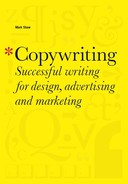Case Study: Serious Waste Management
Roger Horberry has 20 years of experience writing all types of brand, marketing, and advertising copy, both as an in-house and freelance copywriter. The rebranding brief for a local waste-management firm didn’t set him on fire initially, but he soon found his copy solutions were leading the development of a powerful and highly successful new brand.

create competitive advantage through branding
The owner and managing director of Envirotech Waste Services, David Birkett, met with Jonathan Sands, managing director of Elmwood, a design and branding agency that I worked for as a copywriter. The brief was to rebrand a sewerage processing plant. The client specialized in small-to medium-sized organic sewerage processing units for those not connected to the main sewers, and was trading across the UK’s North Midlands.
David explained his business to Jonathan along the lines of “it’s important that MDs of all businesses take care of their waste processing. If not, they can be personally liable for up to £20,000 – this is serious shit.” Jonathan briefed me that his idea was to call them “Serious” and that I should develop “Serious”’ as the angle. I worked alongside a project manager and designer to build the brand.
The copy brief was to play around with the idea of “shit” and how to bring this to life and make it interesting, and not to be afraid of adding a bit of humor, of the saucy seaside postcards type, aiming to be “naughty but nice” but avoiding causing any offense. The team next to me in the studio had just been given a really glamorous brief for fashion retailer Marks & Spencer’s lingerie, and all I could think was “why do you mock me oh Lord?”
The Approach:
straight-talking and tons of bulls**t
My motto is “make it interesting” because people remember what interests them. In Information Anxiety, Richard Saul Wurman says that people don’t “forget” things, they just never remembered it in the first place because it was too boring.
Everyone always wants to get involved, and great original ideas can become mixed in with other ideas. We have to find them and tell them apart from the bad ones, and this is an instinctive process that requires a lot of experience – it is all about spotting the interest.
Once I have formulated an idea I stress-test it, and optimize it. I get it down on paper in the optimum form of words. Once it has been through this process, the mechanical side of writing the copy is the easy bit. Once you get the thinking right, the words will come.
I love creating copy systems, where we can crank the handle and the solutions can just run and run. However, it requires care because if we fiddle with it, the house of cards can come tumbling down. We only did one concept for Serious and there was no need to revise it, create alternatives, or develop second ideas. There was no conflict or drama.
The brand was not something to hide behind the scenes. The brand strapline (“It’s serious **it”) is basically a play on “it’s shit,” using asterisks to avoid offense. To fully express the brand, we painted the company’s tankers brown and dressed the staff in brown uniforms. Unfortunately, some staff left, but others joined because they liked the brand image.
Once we got the theme right we could run with it. We did wordplays around the words “shit” and “it” and created a list of words and phrases that we could use. Our team loved the list, and we set them in the brand style and presented them to the client. He is a very conservative North Midlands businessman, but went with our ideas from the start. He had the courage to implement a radical idea.
The Result:
where there’s muck there’s brass
Serious is the clearest example I’ve ever seen of a brand, and its copy, paying off. The client’s business made a lot more money after the rebrand and business is booming. There was no other marketing activity or additional spend on advertising, and turnover and profit has increased. The communications consisted of the brand, and the tankers – great big, shit-colored tankers driving around Macclesfield!
The brand did not so much come from an initial vision of the end result, it was built up in stages. Jonathan led with the “serious” theme, I developed the straplines and advertising lines, the designer brought it to life visually, and the project manager ensured the brand was implemented in the right places. It was very easy really.
Clients will often say “my manager might not like it” but in the case of Serious, David is in charge and has no shareholder opinions to worry about. Having one decision-maker in the process is the key to the successful use of language in brand communications. Trying to maintain creative ideas when the approval has to go through a board, committee, or middle-managers can be soul-destroying, and the writer usually has little influence or power in the process. Wherever possible I want to deal directly with the guy or girl who makes the final decision.
The quality I love the most in a client is the balls to go with an idea and not stamp out its originality. Some clients actively strip out language and ideas on the basis that it will offend someone, but I believe that if you don’t risk offending, you will never interest anyone.
